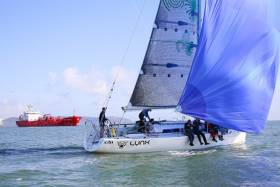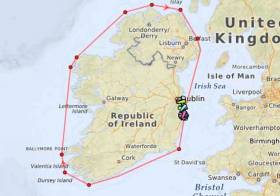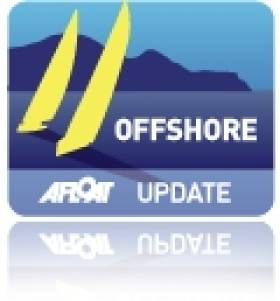Displaying items by tag: tracker
RORC Caribbean 600 2022 Race Tracker Here!
Competing boats in the 2022 RORC Caribbean 600 Race are equipped with tracking beacons by YB Tracking.
The 600nm course circumnavigates 11 Caribbean Islands starting from Fort Charlotte, English Harbour, Antigua and heads north as far as St Martin and south to Guadeloupe taking in Barbuda, Nevis, St Kitts, Saba and St Barths.
View the tracking application below
In view of the light wind forecast this weekend ISORA are making provisions for a finish outside Dublin Bay for its fourth race of the series from Holyhead to Dun Laoghaire tomorrow. ISORA will also be using virtual waypoints for the 50–mile race.
The forecast appears to be no deterrent as a bumper fleet of 29 has confirmed for the Irish Sea duel. The ISORA fleet nearly broke the 30–boat ceiling except for two unavoidable last minute pull–outs this morning.
The reason behind a Kish light as opposed to a Pier finish is that it is envisaged that there will be no wind in the bay when the fleet arrives late tomorrow afternoon.
The tracker managed finish line – between North Kish and Kish light will give accurate crossing times to within approx five seconds. Is this is the first time an offshore race has been 100% finished using technology alone?
ISORA Holyhead – Douglas Race Tracker Live Here!
#ISORA – Race 4 - from Holyhead to Douglas, Isle of Man starts on Friday evening at 1915 hrs and the night race will provide many challenges for the fleet with the decision taken by the Organising Authority to declare the Traffic Separation Scheme (TSS) to the north of Skerries an exclusion zone.
TIME OF START FOR ALL CLASSES
19.10 Warning signal - Class flags (Numerals 1 & 2) hoisted
19.11 Preparatory Signal - Blue Peter hoisted
19.14 Blue Peter down
19.15 Start – Class flags down
The start may be broadcast on VHF Channel 37 (M1)
STARTING LINE
The start line shall be between the end of the Holyhead breakwater and the Clippera Buoy – 0.6 miles off pier head, bearing 067(T).
THE COURSE (approx 60 miles)
Start – Holyhead
Course to be decided
Finish – Douglas IOM
The course is approximately 60 mile long. The course will be posted on the ISORA website, texted and emailed to all entries and shall be available on Thursday morning 21st May. The course shall be broadcast on VHF Channel 37 (M1) before the start.
WAYPOINT MARKS
Waypoints may be used as marks. If so, Rule 28 will be amended accordingly in accordance with the RYA / RORC Guidance – "Racing Around Waypoints" See website for details
Evidence of rounding the "virtual" mark must be taken and may be requested by the Race Officer.
This evidence may include:
Photographic (iPhone or similar) evidence of the yacht's GPS showing its position at the mark.
Yacht's chart plotter track showing the yacht rounding the "virtual" mark. This must be
transmittable to ISORA by email.
The onus of proof of having rounded the WAYPOINT mark will be with each yacht.
Avery Crest YB TRACKER
The first 20 boats entered in the race will be fitted with the Avery Crest YB Tracker. The Skipper will have to sign an indemnity to cover the replacement cost of the unit in a situation that the unit gets lost or damaged.
The units can be collected from Peter Ryan at HSC on Friday evening at 17.30. The trackers will be set up for both races that weekend.
In order to set up the units all boats who are entered must declare that they are racing by 12.00 on Thursday 21st May. This declaration is a text to +353 87 2545037 stating that
"Boat name" will be racing on Saturday. This is critical for the efficient running of the tracking system.
The trackers must be returned to Peter Ryan in NYC immediately after the race on Sunday 24th May.
The tracking can be followed on the YB Tracking app for iPhones and Android. On downloading the app, the "ISORA Avery Crest 2015 Series" is purchased. This will give the purchaser full access to all races in the Series. ISORA will benefit from the sale of this app.
Any queries relating to the Avery Crest Trackers should be dealt with by contacting Peter Ryan +353 87 2545037.
FINISH LINE
Leaving channel mark No1 to Port, the finishing line shall be an extension of the line from the end of the Victoria Pier through the No3 Starboard Buoy to Onchan Head (See Chartlet). Boats approaching the finish shall radio "ISORA Finisher" on VHF Channel 6, 10 min before and then when passing between Green Fairway buoy and Breakwater Red.
The finish time and the time at each mark should be recorded in the log by each boat and text to ISORA at +353 87 2545037 as soon as possible after the race as the mandatory Declaration.
#isora – The Race 3 of the ISORA Avery Crest Offshore Series was very special as it was the first time that an ISORA Race was to be recorded using Yellow Brick (YB) satellite trackers that featured on Afloat's home page live during the race from Dun Laoghaire to Holyhead on Saturday. This 'huge step' for ISORA was facilitated by the generous sponsorship of "Avery Crest Ski Chalets Meribel" writes Peter Ryan, Chairman ISORA. Overall results after three races are available to download below.
The sponsorship allowed ISORA to acquire YB trackers to be used in all their races in the future. The use of the trackers brings the challenges and progress of offshore racing "right into your sitting room". In the past the fleet headed off from the start line and disappeared over the horizon, out of sight and unfortunately, out of mind. Now with the superb quality product, YB Trackers, all the boats taking part can be tracked and their progress followed by those left behind. As part of this leading tracking system, people can now download the YB Tracking app and buy the entire ISORA 2015 series of races for €2.99. All races can be replayed and analysed after the race in the comfort of your own home.
Of the 18 entries for the race, 17 came to the start line where National YC Commodore, Larry Power, sent the fleet off direct towards Holyhead at 08.05. The weather forecast for the race was not good since the beginning of the week. Earlier in the week the race promised to be run with very strong winds. However, as the week developed, a window of opportunity opened in the forecast to allow nearly perfect conditions for the race. This window was to close by early Sunday morning when again strong southerly winds were expected on the Irish Sea. With this limited window of opportunity available, the Sailing Committee decided to shorten the course to go direct to Holyhead.
![]()
A screenshot of the ISORA fleet race trackers used for the first time in Saturday's race from Dun Laoghaire to Holyhead. Click here for more
At the start, the winds were North westerly 10-12 knots. The forecast showed that a hole of "no wind" would develop close to the Irish coast by mid-day and it was vital that the fleet made progress away from the land immediately after the start. The fleet, lead by the Adrian Lee's Cookson 50 "Lee Overlay", sped under spinnaker out of the bay towards Holyhead. With the tide turning north just after the start, the fleet were pushed north.
Soon into the race, there was little sign of the "hole" appearing and the fleet sped towards Holyhead with an ETA of 15.30 for most of the fleet. In the fleet there were five J109s. "Jedi", now sailed two-handed got into some spinnaker hoist difficulties are the start and fell to the rear of the fleet. "Wakey Wakey" also had problems at the start and also fell towards the rear. The remaining three J109s, "Ruth", "Mojito" and "Sgrech" commenced a battle for position that went on for nearly five hours with less than a boat length between the three.
Then the "Hole" arrived!! The fleet slowed down to a near halt. This was made worse by the significant "lop" on the sea, making progress very difficult. "Lee Overlay" who sped away from the fleet after the start, appeared to have sailed very north and probably around the hole. They make cracking progress sailing a most northerly course until due north of the Skerries. There they gybed into a strong foul tide but heading for the finish line in Holyhead.
The remainder of the fleet were caught in the "hole" and all progress stopped for approximately two hours. Two handed "Bam" and J109, "Ruth", were first to break and head off at speed towards Holyhead followed eventually by the fleet.
On the approach to Holyhead, many of the fleet underestimated the strength of the south going tide cross the mouth of the harbour and, while only slightly below the course to the end of the breakwater, got trapped in the tide and made very little progress toward the end of the pier end. This "faux pas" allowed the main fleet to regain contact with the leading part of the fleet.
"Lee Overlay" had an easy passage, crossing the finish line at Holyhead at 14.26 and turned on the line to head back to Dun Laoghaire. The next boat to arrive was "Bam" at 17.00. The last boat to cross the finish Line, manned by Dawn Russell of Holyhead sailing Club, was "Lady Rowena" at 19.33. At this stage "Lee Overlay" had nearly arrived back to its berth in Dun Laoghaire marina.
Adrian Lee's " Lee Overlay" took an easy overall and Class 1 win on his first cross channel in ISORA since his return to racing in the Irish Sea. David Simpson's Swan "Albireo" took Class 2 and Silver Class. The downwind racing did not suit the J's with "Ruth" taking 3rd place overall behind "Bam".
The next two races involve a weekend of offshore racing with a race from Holyhead to Douglas on Friday evening, 22nd May, followed by a second race starting early Sunday morning 23rd May from Douglas to Dun Laoghaire. These races can be followed by downloading the YB tracking app or on the tracker viewer on the ISORA website www.isora.org .
These are exciting times for ISORA. The use of the YB trackers is a critical cog in the progress and development of offshore racing in these waters.
#isora – Today's ISORA offshore race has been confirmed as starting at the DBSC Pier Mark on Dublin Bay with a direct to finish at Holyhead, a distance of some 54–nautical miles. Follow the race on the tracker above. Winds are forecast to be light for the crossing, west to north west in direction and no more than 12 knots. Stroner winds from the south are due this evening. The reigning ISORA champion Ruth skippered by Liam Shanahan was the winner of April's first race coastal race of the season, a fortnight ago and is racing again this morning. Today's race features 18 starters made up of 13 from the Irish offshore fleet and five welsh boats. The start time is 0800 hours. More information and a copy of the sailing instructions is here.
Round Ireland Yacht Race Tracker 2022 Here!
The 21st staging of the biennial 704–mile SSE Renewables Round Ireland Race race around our island home gets underway at 1 pm on Saturday, June 18th.
Follow the race on the live Yellowbrick tracker below
Read all the latest Roiund Ireland 2022 race news in Afloat's regular race updates in one handy Round Ireland link
Track Round Ireland Speed Sailing Record Bid Here!
#roundirelandrecord – Damian Foxall's Round Ireland speed sailing record bid due to start Friday, March 22nd has not got off to the most auspicious start. Battered by strong winds and big waves in the Irish Sea the giant tri under skipper Sidney Gavignet has been reduced to bare poles on its 1000km delivery trip from Lorient, France. The crew is 'on stand-by' and currently looking for shelter on the Welsh coast (1500 Friday) before attempting the Dublin Bay startline. There are unconfirmed reports now that the attempt will be postponed until tomorrow (Saturday). Track the progress of the giant MOD 70 trimaran via the Yellow GPS tracker (above) on Afloat.ie. Remember – once they cross the Dun Laoghaire line 44 hours is the record time to beat! Read WM Nixon's review of all previous Round Ireland speed records dating back to 1899 here!
The Sultanate of Oman's MOD70 flagship Musandam-Oman Sail is due to kick off a busy racing season with this Round Ireland Record attempt but it is only one part of the crew's busy season. French skipper Sidney Gavignet returns to lead the 6-man crew made up of Omani sailors and well-known international pros (including our own Damian Foxall) for a season that will also include the Route des Princes and the Rolex Fastnet Race in August.
Gavignet's new look crew on Oman's flagship Multi One Design 70 Musandam-Oman Sail have brought with them new expectations for the 2013 season as their preparations start in earnest this week with an attempt on the long-standing Round Ireland record.
As part of an intensive three week training programme, the Oman Sail crew, featuring three new faces from last season, will make a bid on the 20 year-old record as a practice run for the team's busy racing schedule later this summer.
The 700-mile sprint through the lumpy Irish Seas and the Atlantic Ocean is sure to be a baptism of fire for one of the new crew, Omani sailor Ahmed Al Maamari who only recently stepped aboard the MOD70.


























